Sensor Technologies for Safety Monitoring in Mine Tailings Storage Facilities: Solutions in the Industry 4.0 Era
Abstract
:1. Introduction
1.1. Mine Tailings Storage Facility Dam Failures: Geotechnical Human Errors or Unavoidable Accidents
- FM-1, slope instability: MPs are settlement, rotation, displacement, tension cracks, and pore pressure change.
- FM-2, seepage: MPs are settlement, seepage quantity, and seepage quality.
- FM-3, foundation: MPs are rotation, displacement, and tension cracks.
- FM-4, earthquake: MPs are ground acceleration, settlement, and pore pressure change.
- FM-5, overtopping of dam crest: MP is freeboard change.
- FM-6, structural: MPs are tension cracks, displacement, and seepage.
- FM-7, internal erosion (piping): MPs are surface elevation changes, effluent quantity, and effluent quality.
- FM-8, subsidence: MPs are ground acceleration and settlement.
1.2. Smart Sensors for Structural Health and Safety Management Monitoring in Mine Tailings Storage Facilities, Considering Digitalization Technologies and the Industry 4.0 Paradigm
1.3. Article Aims
- RQ1: How can the sensor concepts applied to TSF be clustered and how have they evolved?
- RQ2: What are the main engineering disciplines in which sensors are applied?
- RQ3: What timescale is used to record measurements with sensor technologies?
- RQ4: Are the data measurements conducted remotely or on-site with sensor technologies?
- RQ5: What types of sensor technology are applied?
- RQ6: What connectivity technology is applied in sensors?
- RQ7: Where are sensors applied within a mine TSF?
- RQ8: What technologies related to Industry 4.0 are currently being linked to sensors?
2. Methodology and Resources for the Literature Review
2.1. Materials
2.1.1. Web of Science and Scopus Scientific Databases
2.1.2. Data Processing Software
2.2. Methodology
2.2.1. Bibliometric Analysis and Systematic Content Review
2.2.2. Scientific Publication Selection Process
3. Results
3.1. Article Screening Process
3.2. Bibliometric Analysis Results for Sensors Monitoring Mine Tailings Storage Facilities
3.2.1. Annual Quantitative Distribution of Literature
3.2.2. Country and Global Hemisphere Distribution of Selected Articles
3.2.3. Quantitative Analysis of Document Type
3.2.4. Keyword Co-Occurrence Analysis
3.3. Systematic Content Review Results for Sensors Monitoring Mine Tailings Storage Facilities
3.3.1. Content-Based Data Perspective Analysis
- Fiber optic and/or coaxial cable. Communication systems based on fiber optics and/or coaxial cable have been used routinely in the telecommunications and mining industries. These systems’ advantages are (i) they allow the automatic control of variables, (ii) they allow real-time diagnosis, (iii) they offer perpetual operation without maintenance, (iv) they allow control during post-operation, (v) they can transmit data over long distances, and (vi) they can transmit large amounts of data (high transfer rate compared to other wired systems).
- Satellite communication or radio communication. These systems allow communication at any time, anywhere, and on any device. Their advantages include (i) simultaneous communication to several receivers and (ii) the capacity to transmit early community warnings.
3.3.2. Main Applications of Sensor Use to Monitor the Structural Health and Safety Management of TSFs
3.3.3. Comparision of the Main Characteristics of the Articles Selected Dealing with Sensors Monitoring Mine Tailings Storage Facilities
- Regarding the space scale of data measurements, 67% of the cases involve remote measurements, while 29% utilize on-site measurements, and the remaining 4% of the documents do not specify. There is a clear tendency toward remote systems with sensors (telemetry technologies) for mine TSF monitoring.
- When studying the type of operation of sensor systems, 90% of the studies mention automatic applications with real-time data collection, and 2% indicate manual non-real-time data collection. Finally, 8% of the documents do not specify the operation information. This shows that monitoring mine TSF activities in real time is preferred.
- Regarding the connectivity of sensor systems, 21% of the documents mention satellite, 15% mention Zigbee, 17% mention 4G, 10% do not specify a connectivity method, and 42% mention other applications. This shows a tendency to use wireless sensor connections in mine TSF monitoring applications.
- Analyzing the area of the mine TSF where sensor systems are applied reveals that 27% are applied in the dam area, 23% in the reservoir level area, 13% in the tailings beach area, 17% in unspecified areas, and 19% in other areas of the TSF. This affirms that the current monitoring emphasis in TSFs with sensor systems is on the dam and reservoir areas.
- Regarding engineering disciplines, the discipline mentioned most often is geotechnics, at 19%, then mining at 15%, civil engineering at 13%, and others at 52%, including the emerging discipline of data science. This shows that structural stability aspects are a priority in the use of sensor systems in mining.
- Considering the use of sensors with wired or wireless connections, 67% of the cases indicate wireless connections, while 13% correspond to cable connections, and 19% are unspecified. This demonstrates a clear trend toward the use of wireless sensor systems, reflecting the application of IoT and Industry 4.0 technologies.
- Regarding the technologies linked to Industry 4.0, 23% of the cases are not specified. However, 21% of the cases mention AI, 17% mention the IoT, 13% mention CC, and 25% mention other technologies. This shows that sensor systems are often linked to AI and IoT approaches, but massive integration with other Industry 4.0 technologies such as digital twins (DT) remains lacking.
- The cost analysis reveals that, although all applications claim to reduce costs, this characteristic is rarely documented in the scientific literature.
4. Discussion
4.1. Advances
- Geotechnical instrumentation: Sensors and measurement devices used to monitor parameters such as pore pressure, soil deformation, water pressure, inclination, and vibration. These sensors can provide real-time data on TSFs’ structural behavior.
- Telemetry systems: Data collected by sensors can be transmitted wirelessly or through wired communication networks for remote analysis and monitoring. This allows experts to assess TSFs’ physical stability and make informed decisions.
- Data modeling and analysis: The collected data can be used to create geotechnical models and perform risk analyses. These models help predict future structural behavior and enable data-driven decision-making.
- Satellite monitoring: Satellite images can be used to monitor changes in the surfaces of dams and reservoir areas, such as movements or deformations. These provide an overview of the state of the infrastructure over time.
4.2. Gaps
4.3. Future Trends
- A tool for monitoring critical parameters with different instrumentation systems via sensors, the verification of threshold values, and the simulation of the most common failure scenarios.
- A tool to periodically verify the status of the TSF that considers elements of vulnerability and deviations from the design and analyzes the occurrence of adverse triggering events.
- An integrative and predictive tool that relates the information from the monitoring system and the verification system through fault trees and predictive models that use AI and ML approaches.
5. Conclusions
Author Contributions
Funding
Data Availability Statement
Conflicts of Interest
Abbreviations
| TSFs | Tailings Storage Facilities |
| BATs | Best Available Technologies |
| BAPs | Best Applicable Practices |
| BEPs | Best Environmental Practices |
| REEs | Rare Earth Elements |
| RQs | Research Questions |
| FM | Failure Modes |
| MP | Monitoring Parameters |
| WoS | Web of Science |
| DEM | Data Extraction from Metadata |
| DEC | Data Extraction from Content |
| EC | Exclusion Criteria |
| ICTs | Information and Communication Technologies |
| AI | Artificial Intelligence |
| IoT | Internet of Things |
| IIoT | Industrial Internet of Things |
| CC | Cloud Computing |
| ML | Machine Learning |
| DT | Digital Twins |
| CNNs | Convolutional Neural Networks |
| RF | Random Forest |
| EoR | Engineer of Record |
| ATS | Automated Total Stations |
| GPS | Global Positioning System |
| GNSS | Global Navigation Satellite System |
| SSR | Secondary Surveillance RADAR |
| InSAR | Interferometric Synthetic Aperture RADAR |
| LIDAR | Light Detection and Ranging |
| UAV | Unmanned Aerial Vehicles |
| USV | Unmanned Survey Vessels |
| DSR | Dam Safety Review |
| ITRB | Independent Tailings Review Board |
| 4G | Internet of high velocity of 4th generation |
| RM | Remote Sensor |
| CCTV | Closed-Circuit Television Camera |
| PLC | Programmable Logic Controllers |
| SCADA | Supervisory Control and Data Acquisition |
| DCS | Distributed Control Systems |
| PCA | Principal Component Analysis |
| KPI | Key Performance Indicator |
| CSR | Corporate Social Responsibility |
| ESG | Environmental Social and Governance |
| SDGs | Sustainable Development Goals |
| UN | United Nations |
| PRI | Principles for Responsible Investment |
| ICMM | International Council on Mining and Metals |
| GISTM | Global Industry Standard on Tailings Management |
| ALARP | As Low As Reasonably Practicable |
| APPs | Software Applications |
| masl | Meters above sea level |
References
- Dong, L.; Deng, S.; Wang, F. Some developments and new insights for environmental sustainability and disaster control of tailings dam. J. Clean. Prod. 2020, 269, 122270. [Google Scholar] [CrossRef]
- Rana, N.M.; Ghahramani, N.; Evans, S.G.; Small, A.; Skermer, N.; McDougall, S.; Andy Take, W. Global magnitude-frequency statistics of the failures and impacts of large water-retention dams and mine tailings impoundments. Earth-Sci. Rev. 2022, 232, 104144. [Google Scholar] [CrossRef]
- Piciullo, L.; Storrøsten, E.B.; Liu, Z.; Nadim, F.; Lacasse, S. A new look at the statistics of tailings dam failures. Eng. Geol. 2022, 303, 106657. [Google Scholar] [CrossRef]
- Cacciuttolo, C.; Cano, D. Spatial and Temporal Study of Supernatant Process Water Pond in Tailings Storage Facilities: Use of Remote Sensing Techniques for Preventing Mine Tailings Dam Failures. Sustainability 2023, 15, 4984. [Google Scholar] [CrossRef]
- Silva Rotta, L.H.; Alcântara, E.; Park, E.; Negri, R.G.; Lin, Y.N.; Bernardo, N.; Mendes, T.S.G.; Filho, C.R.S. The 2019 Brumadinho tailings dam collapse: Possible cause and impacts of the worst human and environmental disaster in Brazil. Int. J. Appl. Earth Obs. Geoinf. 2020, 90, 102119. [Google Scholar] [CrossRef]
- dos Santos Vergilio, C.; Lacerda, D.; da Silva Souza, T.; de Oliveira, B.C.V.; Fioresi, V.S.; de Souza, V.V.; da Rocha Rodrigues, G.; de Araujo Moreira Barbosa, M.K.; Sartori, E.; Rangel, T.P.; et al. Immediate and long-term impacts of one of the worst mining tailing dam failure worldwide (Bento Rodrigues, Minas Gerais, Brazil). Sci. Total Environ. 2021, 756, 143697. [Google Scholar] [CrossRef] [PubMed]
- Armstrong, M.; Petter, R.; Petter, C. Why have so many tailings dams failed in recent years? Resour. Policy 2019, 63, 101412. [Google Scholar] [CrossRef]
- Cheng, D.; Cui, Y.; Li, Z.; Iqbal, J. Watch out for the tailings pond, a sharp edge hanging over our heads: Lessons learned and perceptions from the brumadinho tailings dam failure disaster. Remote Sens. 2021, 13, 1775. [Google Scholar] [CrossRef]
- Kemp, D.; Owen, J.R.; Lèbre, É. Tailings facility failures in the global mining industry: Will a ‘transparency turn’ drive change? Bus. Strategy Environ. 2021, 30, 122–134. [Google Scholar] [CrossRef]
- Hatje, V.; Pedreira, R.M.A.; De Rezende, C.E.; Schettini, C.A.F.; De Souza, G.C.; Marin, D.C.; Hackspacher, P.C. The environmental impacts of one of the largest tailing dam failures worldwide. Sci. Rep. 2017, 7, 10706. [Google Scholar] [CrossRef]
- Islam, K.; Murakami, S. Global-scale impact analysis of mine tailings dam failures: 1915–2020. Glob. Environ. Chang. 2021, 70, 102361. [Google Scholar] [CrossRef]
- Owen, J.R.; Kemp, D.; Lèbre Svobodova, K.; Pérez Murillo, G. Catastrophic tailings dam failures and disaster risk disclosure. Int. J. Disaster Risk Reduct. 2020, 42, 101361. [Google Scholar] [CrossRef]
- Cacciuttolo, C.; Atencio, E. Dry Stacking of Filtered Tailings for Large-Scale Production Rates over 100,000 Metric Tons per Day: Envisioning the Sustainable Future of Mine Tailings Storage Facilities. Minerals 2023, 13, 1445. [Google Scholar] [CrossRef]
- Agusdinata, D.B.; Liu, W. Global sustainability of electric vehicles minerals: A critical review of news media. Extr. Ind. Soc. 2023, 13, 101231. [Google Scholar] [CrossRef]
- Solé, J. Climate and Energy Crises from the Perspective of the Intergovernmental Panel on Climate Change: Trade-Offs between Systemic Transition and Societal Collapse? Sustainability 2023, 15, 2231. [Google Scholar] [CrossRef]
- Holechek, J.L.; Geli, H.M.E.; Sawalhah, M.N.; Valdez, R. A Global Assessment: Can Renewable Energy Replace Fossil Fuels by 2050? Sustainability 2022, 14, 4792. [Google Scholar] [CrossRef]
- Araya, N.; Mamani Quiñonez, O.; Cisternas, L.A.; Kraslawski, A. Sustainable Development Goals in Mine Tailings Management: Targets and Indicators. Mater. Proc. 2021, 5, 82. [Google Scholar] [CrossRef]
- Lim, B.; Alorro, R.D. Technospheric Mining of Mine Wastes: A Review of Applications and Challenges. Sustain. Chem. 2021, 2, 686–706. [Google Scholar] [CrossRef]
- Cacciuttolo, C.; Atencio, E. Past, Present, and Future of Copper Mine Tailings Governance in Chile (1905–2022): A Review in One of the Leading Mining Countries in the World. Int. J. Environ. Res. Public Health 2022, 19, 13060. [Google Scholar] [CrossRef]
- Cacciuttolo, C.; Cano, D.; Custodio, M. Socio-Environmental Risks Linked with Mine Tailings Chemical Composition: Promoting Responsible and Safe Mine Tailings Management Considering Copper and Gold Mining Experiences from Chile and Peru. Toxics 2023, 11, 462. [Google Scholar] [CrossRef]
- Cacciuttolo, C.; Pastor, A.; Valderrama, P.; Atencio, E. Process Water Management and Seepage Control in Tailings Storage Facilities: Engineered Environmental Solutions Applied in Chile and Peru. Water 2023, 15, 196. [Google Scholar] [CrossRef]
- Labonté-Raymond, P.L.; Pabst, T.; Bussière, B.; Bresson, É. Impact of climate change on extreme rainfall events and surface water management at mine waste storage facilities. J. Hydrol. 2020, 590, 125383. [Google Scholar] [CrossRef]
- Innis, S.; Kunz, N.C. The role of institutional mining investors in driving responsible tailings management. Extr. Ind. Soc. 2020, 7, 1377–1384. [Google Scholar] [CrossRef]
- Schoenberger, E. Environmentally sustainable mining: The case of tailings storage facilities. Resour. Policy 2016, 49, 119–128. [Google Scholar] [CrossRef]
- Adiansyah, J.S.; Rosano, M.; Vink, S.; Keir, G. A framework for a sustainable approach to mine tailings management: Disposal strategies. J. Clean. Prod. 2015, 108, 1050–1062. [Google Scholar] [CrossRef]
- Cacciuttolo Vargas, C.; Marinovic Pulido, A. Sustainable Management of Thickened Tailings in Chile and Peru: A Review of Practical Experience and Socio-Environmental Acceptance. Sustainability 2022, 14, 10901. [Google Scholar] [CrossRef]
- Cacciuttolo Vargas, C.; Pérez Campomanes, G. Practical Experience of Filtered Tailings Technology in Chile and Peru: An Environmentally Friendly Solution. Minerals 2022, 12, 889. [Google Scholar] [CrossRef]
- Ledesma, O.; Sfriso, A.; Manzanal, D. Procedure for assessing the liquefaction vulnerability of tailings dams. Comput. Geotech. 2022, 144, 104632. [Google Scholar] [CrossRef]
- Hamraoui, L.; Bergani, A.; Ettoumi, M.; Aboulaich, A.; Taha, Y.; Khalil, A.; Neculita, C.M.; Benzaazoua, M. Towards a Circular Economy in the Mining Industry: Possible Solutions for Water Recovery through Advanced Mineral Tailings Dewatering. Minerals 2024, 14, 319. Available online: https://www.mdpi.com/2075-163X/14/3/319 (accessed on 30 March 2024). [CrossRef]
- Kossoff, D.; Dubbin, W.E.; Alfredsson, M.; Edwards, S.J.; Macklin, M.G.; Hudson-Edwards, K.A. Mine tailings dams: Characteristics, failure, environmental impacts, and remediation. Appl. Geochem. 2014, 51, 229–245. [Google Scholar] [CrossRef]
- Hancock, G.R. A method for assessing the long-term integrity of tailings dams. Sci. Total Environ. 2021, 779, 146083. [Google Scholar] [CrossRef] [PubMed]
- Cacciuttolo, C.; Guzmán, V.; Catriñir, P.; Atencio, E.; Komarizadehasl, S.; Lozano-Galant, J.A. Low-Cost Sensors Technologies for Monitoring Sustainability and Safety Issues in Mining Activities: Advances, Gaps, and Future Directions in the Digitalization for Smart Mining. Sensors 2023, 23, 6846. [Google Scholar] [CrossRef] [PubMed]
- Lu, Z. Research on the optimization analysis and monitoring elements of tailings pond. IOP Conf. Ser. Earth Environ. Sci. 2020, 558, 022082. [Google Scholar] [CrossRef]
- Clarkson, L.; Williams, D.; Seppälä, J. Real-time monitoring of tailings dams. Georisk 2021, 15, 113–127. [Google Scholar] [CrossRef]
- Sun, E.; Zhang, X.; Li, Z. The internet of things (IOT) and cloud computing (CC) based tailings dam monitoring and pre-alarm system in mines. Saf. Sci. 2012, 50, 811–815. [Google Scholar] [CrossRef]
- Dong, L.; Shu, W.; Sun, D.; Li, X.; Zhang, L. Pre-Alarm System Based on Real-Time Monitoring and Numerical Simulation Using Internet of Things and Cloud Computing for Tailings Dam in Mines. IEEE Access 2017, 5, 21080–21089. [Google Scholar] [CrossRef]
- Clarkson, L.; Williams, D. Catalogue of real-time instrumentation and monitoring techniques for tailings dams. Min. Technol. Trans. Inst. Min. Metall. 2021, 130, 52–59. [Google Scholar] [CrossRef]
- Zhironkin, S.; Ezdina, N. Review of Transition from Mining 4.0 to Mining 5.0 Innovative Technologies. Appl. Sci. 2023, 13, 4917. [Google Scholar] [CrossRef]
- Barnewold, L.; Lottermoser, B.G. Identification of digital technologies and digitalisation trends in the mining industry. Int. J. Min. Sci. Technol. 2020, 30, 747–757. [Google Scholar] [CrossRef]
- Zhironkin, S.; Gasanov, M.; Suslova, Y. Orderliness in Mining 4.0. Energies 2022, 15, 8153. [Google Scholar] [CrossRef]
- Smith, K.; Sepasgozar, S. Governance, Standards and Regulation: What Construction and Mining Need to Commit to Industry 4.0. Buildings 2022, 12, 1064. [Google Scholar] [CrossRef]
- Yaqub, M.Z.; Alsabban, A. Industry-4.0-Enabled Digital Transformation: Prospects, Instruments, Challenges, and Implications for Business Strategies. Sustainability 2023, 15, 8553. [Google Scholar] [CrossRef]
- Zhironkina, O.; Zhironkin, S. Technological and Intellectual Transition to Mining 4.0: A Review. Energies 2023, 16, 1427. [Google Scholar] [CrossRef]
- Aziz, A.; Schelén, O.; Bodin, U. A Study on Industrial IoT for the Mining Industry: Synthesized Architecture and Open Research Directions. IoT 2020, 1, 529–550. [Google Scholar] [CrossRef]
- Wan, X.; Sun, L.; Tian, H.; Huang, Z.; Yang, H. Research on 3S integration technology in the tailings pond monitoring. Adv. Mater. Res. 2012, 356–360, 688–692. [Google Scholar] [CrossRef]
- Hui, S.; Charlebois, L.; Sun, C. Real-time monitoring for structural health, public safety, and risk management of mine tailings dams. Can. J. Earth Sci. 2018, 55, 221–229. Available online: https://mc06.manuscriptcentral.com/cjes-pubs (accessed on 22 December 2023). [CrossRef]
- Wang, Y.; Mei, G.; Wang, S.; Li, X. Application of information technology in safety monitoring and early warning of tailings pond. J. Phys. Conf. Ser. 2021, 1961, 012018. [Google Scholar] [CrossRef]
- International Council on Mining and Metals (ICMM). Tailings Reduction Roadmap. 2022. Available online: https://www.icmm.com/en-gb/guidance/innovation/2022/tailings-reduction-roadmap (accessed on 1 April 2024).
- Donthu, N.; Kumar, S.; Mukherjee, D.; Pandey, N.; Lim, W.M. How to conduct a bibliometric analysis: An overview and guidelines. J. Bus. Res. 2021, 133, 285–296. [Google Scholar] [CrossRef]
- Oláh, J.; Krisán, E.; Kiss, A.; Lakner, Z.; Popp, J. PRISMA statement for reporting literature searches in systematic reviews of the bioethanol sector. Energies 2020, 13, 2323. [Google Scholar] [CrossRef]
- Boaye Belle, A.; Zhao, Y. Evidence-Based Software Engineering: A Checklist-Based Approach to Assess the Abstracts of Reviews Self-Identifying as Systematic Reviews. Appl. Sci. 2022, 12, 9017. [Google Scholar] [CrossRef]
- Chigbu, U.E.; Atiku, S.O.; Du Plessis, C.C. The Science of Literature Reviews: Searching, Identifying, Selecting, and Synthesising. Publications 2023, 11, 2. [Google Scholar] [CrossRef]
- Atencio, E.; Bustos, G.; Mancini, M. Enterprise Architecture Approach for Project Management and Project-Based Organizations: A Review. Sustainability 2022, 14, 9801. [Google Scholar] [CrossRef]
- Simonsen, E.M.; Herrera, R.F.; Atencio, E. Benefits and Difficulties of the Implementation of Lean Construction in the Public Sector: A Systematic Review. Sustainability 2023, 15, 6161. [Google Scholar] [CrossRef]
- Galaz-Delgado, E.I.; Herrera, R.F.; Atencio, E.; Rivera, F.M.L.; Biotto, C.N. Problems and challenges in the interactions of design teams of construction projects: A bibliometric study. Buildings 2021, 11, 461. [Google Scholar] [CrossRef]
- Jia, C.; Mustafa, H. A Bibliometric Analysis and Review of Nudge Research Using VOSviewer. Behav. Sci. 2023, 13, 19. [Google Scholar] [CrossRef] [PubMed]
- Kirby, A. Exploratory Bibliometrics: Using VOSviewer as a Preliminary Research Tool. Publications 2023, 11, 10. [Google Scholar] [CrossRef]
- Kuzior, A.; Sira, M. A Bibliometric Analysis of Blockchain Technology Research Using VOSviewer. Sustainability 2022, 14, 8206. [Google Scholar] [CrossRef]
- World Sensing. How Monitoring Can Help Make Tailings Dams Safer. 2019. Available online: https://www.worldsensing.com/resource/safer-monitoring-tailings-dams/ (accessed on 27 February 2024).
- Jeong, Y.; Kim, K. A Case Study: Determination of the Optimal Tailings Beach Distance as a Guideline for Safe Water Management in an Upstream TSF. Min. Met. Explor. 2020, 37, 141–151. [Google Scholar] [CrossRef]
- Adriaan Basson, J.; Broekman, A.; Willem Jacobsz, S. TD-DAQ: A low-cost data acquisition system monitoring the unsaturated pore pressure regime in tailings dams. HardwareX 2021, 10, 221. Available online: http://creativecommons.org/licenses/by/4.0/ (accessed on 23 December 2023).
- Wu, T.; Zhang, C.; Zhao, Y. A study on faults diagnosis and early-warning method of tailings reservoir monitoring points based on intelligent discovery. Int. J. Perform. Eng. 2017, 13, 697–710. [Google Scholar] [CrossRef]
- Guan, H.; Yang, P. Advance in Artificial Intelligence Method Safety on Warning of Tailings Dam Break. In ACM International Conference Proceeding Series; Association for Computing Machinery: New York, NY, USA, 2020; pp. 229–234. [Google Scholar]
- Ma, W.; Zhang, L.; Zhang, S.; Liu, Y.; Wang, H. Analysis of quantitative management of online intelligent monitoring of tailing ponds based on the perspective of safety prevention and control. Appl. Math. Nonlinear Sci. 2023, 9, 15–30. [Google Scholar] [CrossRef]
- Dong, K.; Yang, D.; Yan, J.; Sheng, J.; Mi, Z.; Lu, X.; Peng, X. Anomaly identification of monitoring data and safety evaluation method of tailings dam. Front. Earth Sci. 2022, 10, 1016458. [Google Scholar] [CrossRef]
- Zhang, H.; Li, Q.; Wang, J.; Fu, B.; Duan, Z.; Zhao, Z. Application of Space–Sky–Earth Integration Technology with UAVs in Risk Identification of Tailings Ponds. Drones 2023, 7, 222. [Google Scholar] [CrossRef]
- Yu, G.M.; Song, C.W.; Zou, J.B.; Wu, Y.X.; Pan, Y.Z.; Li, L.; Li, R.; Wang, P.-S.; Wang, Y.-L. Applications of online monitoring technology for tailings dam on digital mine. Trans. Nonferrous Met. Soc. China 2011, 21 (Suppl. 3), s604–s609. [Google Scholar] [CrossRef]
- Clarkson, L.; Williams, D. Catalogue of example instrumentation and monitoring systems for tailings dams in Australia. Min. Technol. Trans. Inst. Min. Metall. 2021, 130, 119–129. [Google Scholar] [CrossRef]
- López-Vinielles, J.; Fernández-Merodo, J.A.; Ezquerro, P.; García-Davalillo, J.C.; Sarro, R.; Reyes-Carmona, C.; Barra, A.; Navarro, J.A.; Krishnakumar, V.; Alvioli, M.; et al. Combining satellite insar, slope units and finite element modeling for stability analysis in mining waste disposal areas. Remote Sens. 2021, 13, 2008. [Google Scholar] [CrossRef]
- Lumbroso, D.; Collell, M.R.; Petkovsek, G.; Davison, M.; Liu, Y.; Goff, C.; Wetton, M. DAMSAT: An Eye in the Sky for Monitoring Tailings Dams. Mine Water Environ. 2021, 40, 113–127. [Google Scholar] [CrossRef]
- Hu, J.; Liu, X. Design and implementation of tailings dam security monitoring system. Procedia Eng. 2011, 26, 1914–1921. [Google Scholar] [CrossRef]
- He, X.W.; Sheng, Y.F.; Fan, K.G.; Zheng, L.P.; Cao, Q.M. Design of tungsten tailing reservoir safety monitoring and warning system based on wireless sensor networks and LabVIEW. Appl. Mech. Mater. 2013, 427–429, 1268–1271. [Google Scholar] [CrossRef]
- Li, Q.; Chen, Z.; Zhang, B.; Li, B.; Lu, K.; Lu, L.; Guo, H. Detection of tailings dams using high-resolution satellite imagery and a single shot multibox detector in the Jing-Jin-Ji Region, China. Remote Sens. 2020, 12, 2626. [Google Scholar] [CrossRef]
- Sarker, S.K.; Haque, N.; Bruckard, W.; Bhuiyan, M.; Pramanik, B.K. Development of a geospatial database of tailing storage facilities in Australia using satellite images. Chemosphere 2022, 303, 135139. [Google Scholar] [CrossRef]
- Yang, J.; Sun, Y.; Li, Q.; Sun, Y. Effective risk prediction of tailings ponds using machine learning. In Proceedings of the 2020 3rd International Conference on Advanced Electronic Materials, Computers and Software Engineering, AEMCSE 2020, Shenzhen, China, 24–26 April 2020; Institute of Electrical and Electronics Engineers Inc.: Piscataway, NJ, USA, 2020; pp. 234–238. [Google Scholar]
- Arancibia, G.V.; Bustamante, O.P.; Vigneau, G.H.; Allende-Cid, H.; Fuentelaba, G.S.; Nieto, V.A. Estimation of Moisture Content in Thickened Tailings Dams: Machine Learning Techniques Applied to Remote Sensing Images. IEEE Access 2021, 9, 16988–16998. [Google Scholar] [CrossRef]
- Li, W.; Wang, C. GPS in the tailings dam deformation monitoring. Procedia Eng. 2011, 26, 1648–1657. [Google Scholar] [CrossRef]
- Zhen, Z.; Li, J.; Li, Z. Hazard identification and risk decision-making system of tailings storage facilities based on complex networks. In Proceedings of the 2020 IEEE Joint International Information Technology and Artificial Intelligence Conference (ITAIC), Chongqing, China, 11–13 December 2020; pp. 2119–2123. [Google Scholar]
- Yang, J.; Li, Q.; Sun, Y.; Qian, Z. Measure dry beach length of tailings pond using deep learning algorithm. In ACM International Conference Proceeding Series; Association for Computing Machinery: New York, NY, USA, 2019; pp. 503–508. [Google Scholar]
- Balaniuk, R.; Isupova, O.; Reece, S. Mining and tailings dam detection in satellite imagery using deep learning. Sensors 2020, 20, 6936. [Google Scholar] [CrossRef]
- Wu, T.; Zhang, C.; Zhao, Y. Monitoring and warning methods of tailings reservoir using BP neural network. Int. J. Perform. Eng. 2018, 14, 1171–1180. [Google Scholar] [CrossRef]
- Mura, J.C.; Gama, F.F.; Paradella, W.R.; Negrão, P.; Carneiro, S.; de Oliveira, C.G.; Brandão, W.S. Monitoring the vulnerability of the dam and dikes in Germano iron mining area after the collapse of the tailings dam of fundão (Mariana-MG, Brazil) using DInSAR techniques with terraSAR-X data. Remote Sens. 2018, 10, 1507. [Google Scholar] [CrossRef]
- Jing, Z.; Gao, X. Monitoring and early warning of a metal mine tailings pond based on a deep learning bidirectional recurrent long and short memory network. PLoS ONE 2022, 17, e0273073. [Google Scholar] [CrossRef]
- Stefaniak, K.; Wróżyńska, M. On possibilities of using global monitoring in effective prevention of tailings storage facilities failures. Environ. Sci. Pollut. Res. 2018, 25, 5280–5297. [Google Scholar] [CrossRef]
- Chalkley, R.; Crane, R.A.; Eyre, M.; Hicks, K.; Jackson, K.M.; Hudson-Edwards, K.A. A Multi-Scale Feasibility Study into Acid Mine Drainage (AMD) Monitoring Using Same-Day Observations. Remote Sens. 2023, 15, 76. [Google Scholar] [CrossRef]
- Ruan, S.; Han, S.; Lu, C.W.; Gu, Q. Proactive control model for safety prediction in tailing dam management: Applying graph depth learning optimization. Process Saf. Environ. Prot. 2023, 172, 329–340. [Google Scholar] [CrossRef]
- O’donovan, C.; Adam, E.; Torres-Cruz, L.A. Remote sensing of the decant pond of tailings dams: Insights from a South African case study. J. S. Afr. Inst. Min. Metall. 2022, 122, 10–25. Available online: https://scielo.org.za/pdf/jsaimm/v122n4/03.pdf (accessed on 10 April 2024).
- Zhen, Z.; Wu, X.; Ma, B.; Zhao, H.; Zhang, Y. Propagation network of tailings dam failure risk and the identification of key hazards. Sci. Rep. 2022, 12, 5580. [Google Scholar] [CrossRef]
- Hu, J.; Hu, S.; Kang, F.; Zhang, J. Real-time dry beach length monitoring for tailings dams based on visual measurement. Math. Probl. Eng. 2013, 2013, 935371. [Google Scholar] [CrossRef]
- Hao, L.; Zhang, Z.; Yang, X. Mine tailing extraction indexes and model using remote-sensing images in southeast Hubei Province. Environ. Earth Sci. 2019, 78, 493. [Google Scholar] [CrossRef]
- Chen, Y.; Li, Q.; Liang, Y. Research and application of data classification in risk prediction for tailings reservoirs. In ACM International Conference Proceeding Series; Association for Computing Machinery: New York, NY, USA, 2019. [Google Scholar]
- Zhang, D.; Wang, L.G.; Yang, X.C. Research on tailings pond online safety monitoring system based on Zigbee sensor network. Appl. Mech. Mater. 2014, 602–605, 1728–1732. [Google Scholar] [CrossRef]
- Du, Z.; Ge, L.; Ng, A.H.M.; Zhu, Q.; Horgan, F.G.; Zhang, Q. Risk assessment for tailings dams in Brumadinho of Brazil using InSAR time series approach. Sci. Total Environ. 2020, 717, 137125. [Google Scholar] [CrossRef]
- Li, X.; Li, J.; Liu, C.; Chen, C. Safety monitoring system based on internet of things tailings dam. J. Intell. Fuzzy Syst. 2021, 40, 3005–3014. [Google Scholar] [CrossRef]
- Haiming, L.; Jing, C. Study on automatic safety monitoring and management system of tailings reservoir. Adv. Mater. Res. 2013, 663, 1043–1048. [Google Scholar]
- Li, Q.M.; Wang, Y.H.; Li, G. Tailings dam breach disaster on-line monitoring method and system realization. Procedia Eng. 2011, 26, 1674–1681. [Google Scholar] [CrossRef]
- Lumbroso, D.; McElroy, C.; Goff, C.; Collell, M.R.; Petkovsek, G.; Wetton, M. The potential to reduce the risks posed by tailings dams using satellite-based information. Int. J. Disaster Risk Reduct. 2019, 38, 101209. [Google Scholar] [CrossRef]
- Koperska, W.; Stachowiak, M.; Duda-Mróz, N.; Stefaniak, P.; Jachnik, B.; Bursa, B.; Koperska, B.; Stefanek, P. The Tailings Storage Facility (TSF) stability monitoring system using advanced big data analytics on the example of the Żelazny Most Facility. Arch. Civ. Eng. 2022, 68, 297–311. [Google Scholar]
- Morton, K.L. The Use of Accurate Pore Pressure Monitoring for Risk Reduction in Tailings Dams. Mine Water Environ. 2021, 40, 42–49. [Google Scholar] [CrossRef]
- Mazzanti, P.; Antonielli, B.; Sciortino, A.; Scancella, S.; Bozzano, F. Tracking deformation processes at the legnica glogow copper district (Poland) by satellite insar—II: Żelazny most tailings dam. Land 2021, 10, 654. [Google Scholar] [CrossRef]
- Duarte, J.; Rodrigues, F.; Branco, J.C. Sensing Technology Applications in the Mining Industry—A Systematic Review. Int. J. Environ. Res. Public Health 2022, 19, 2334. [Google Scholar] [CrossRef]
- Bayaraa, M.; Rossi, C.; Kalaitzis, F.; Sheil, B. Entity Embeddings in Remote Sensing: Application to Deformation Monitoring for Infrastructure. Remote Sens. 2023, 15, 4910. [Google Scholar] [CrossRef]
- Edraki, M.; Baumgartl, T.; Manlapig, E.; Bradshaw, D.; Franks, D.M.; Moran, C.J. Designing mine tailings for better environmental, social and economic outcomes: A review of alternative approaches. J. Clean. Prod. 2014, 84, 411–420. [Google Scholar] [CrossRef]
- Zwissler, B.; Oommen, T.; Vitton, S.; Seagren, E.A. Thermal Remote Sensing for Moisture Content Monitoring of Mine Tailings: Laboratory Study. Environ. Eng. Geosci. 2017, 23, 299–312. Available online: https://pubs.geoscienceworld.org/aeg/eeg/article-pdf/23/4/299/4046405/i1078-7275-23-4-299.pdf (accessed on 23 December 2023). [CrossRef]
- Cacciuttolo, C.; Cano, D. Environmental Impact Assessment of Mine Tailings Spill Considering Metallurgical Processes of Gold and Copper Mining: Case Studies in the Andean Countries of Chile and Peru. Water 2022, 14, 3057. [Google Scholar] [CrossRef]
- Soares Fortes, B.C.; Villefort Teixeira, M.C.; Pereira da Costa, S.; Wagner, M.H.; Scotti, M.R. Post-disaster recovery plan for a rural settler’s community affected by the Fundão dam tailings in Brazil. J. Rural Stud. 2022, 93, 55–66. [Google Scholar] [CrossRef]
- Blight, G. Geotechnical Engineering for Mine Waste Storage Facilities; CRC Press: Boca Raton, FL, USA, 2010. [Google Scholar]
- Adiansyah, J.S.; Rosano, M.; Vink, S.; Keir, G.; Stokes, J.R. Synergising water and energy requirements to improve sustainability performance in mine tailings management. J. Clean. Prod. 2016, 133, 5–17. [Google Scholar] [CrossRef]
- Franks, D.M.; Boger, D.V.; Côte, C.M.; Mulligan, D.R. Sustainable development principles for the disposal of mining and mineral processing wastes. Resour. Policy 2011, 36, 114–122. [Google Scholar] [CrossRef]
- Souza LCO de Júnior, O.T.L.; Barros, J.L.; Yamashita, A.S.; Euzébio, T.A.M. Performance Analysis of a Silo-SlideGate-Feeder System to Regulate the Ore Flow by DEM Simulation. J. Control Autom. Electr. Syst. 2022, 33, 1310–1318. [Google Scholar] [CrossRef]
- Aldrich, C.; Avelar, E.; Liu, X. Recent advances in flotation froth image analysis. Miner. Eng. 2022, 188, 107823. [Google Scholar] [CrossRef]
- Matos, S.N.; Pinto, T.V.B.; Domingues, J.D.; Ranieri, C.M.; Albuquerque, K.S.; Moreira, V.S.; Souza, E.S.; Ueyama, J.; Euzébio, Y.; Pessin, G. An Evaluation of Iron Ore Characteristics Through Machine Learning and 2-D LiDAR Technology. IEEE Trans. Instrum. Meas. 2024, 73, 1–11. [Google Scholar] [CrossRef]
- Hazrathosseini, A.; Moradi Afrapoli, A. The advent of digital twins in surface mining: Its time has finally arrived. Resources Policy 2023, 80, 103155. [Google Scholar] [CrossRef]
- Kukushkin, K.; Ryabov, Y.; Borovkov, A. Digital Twins: A Systematic Literature Review Based on Data Analysis and Topic Modeling. Data 2022, 7, 173. [Google Scholar] [CrossRef]
- Bi, L.; Wang, Z.; Wu, Z.; Zhang, Y. A New Reform of Mining Production and Management Modes under Industry 4.0: Cloud Mining Mode. Appl. Sci. 2022, 12, 2781. [Google Scholar] [CrossRef]
- Ni, C.; Li, S.C. Machine learning enabled Industrial IoT Security: Challenges, Trends and Solutions. J. Ind. Inf. Integr. 2024, 38, 100549. [Google Scholar] [CrossRef]
- Barrie, G.; Whyte, A.; Bell, J. IoT security: Challenges and solutions for mining. In ACM International Conference Proceeding Series; Association for Computing Machinery: New York, NY, USA, 2017. [Google Scholar]
- Zanetta-Colombo, N.C.; Fleming, Z.L.; Gayo, E.M.; Manzano, C.A.; Panagi, M.; Valdés, J.; Siegmund, A. Impact of mining on the metal content of dust in indigenous villages of northern Chile. Environ. Int. 2022, 169, 107490. [Google Scholar] [CrossRef]
- Mian, M.H.; Yanful, E.K. Tailings erosion and resuspension in two mine tailings ponds due to wind waves. Adv. Environ. Res. 2003, 7, 745–765. [Google Scholar] [CrossRef]
- Dold, B. Sustainability in metal mining: From exploration, over processing to mine waste management. Rev. Environ. Sci. Biotechnol. 2008, 7, 275–285. [Google Scholar] [CrossRef]
- Zine, H.; El Mansour, A.; Hakkou, R.; Papazoglou, E.G.; Benzaazoua, M. Advancements in Mine Closure and Ecological Reclamation: A Comprehensive Bibliometric Overview (1980–2023). Mining 2023, 3, 798–813. [Google Scholar] [CrossRef]
- Majstorovic, V.; Simeunovic, V.; Miskovic, Z.; Mitrovic, R.; Stosic, D.; Dimitrijevic, S. Smart Manufacturing as a framework for Smart Mining. Procedia CIRP 2021, 104, 188–193. [Google Scholar] [CrossRef]
- Nwaila, G.T.; Frimmel, H.E.; Zhang, S.E.; Bourdeau, J.E.; Tolmay, L.C.K.; Durrheim, R.J.; Ghorbani, Y. The minerals industry in the era of digital transition: An energy-efficient and environmentally conscious approach. Resour. Policy 2022, 78, 102851. [Google Scholar] [CrossRef]
- Novák, P.; Vyskočil, J. Digitalized Automation Engineering of Industry 4.0 Production Systems and Their Tight Cooperation with Digital Twins. Processes 2022, 10, 404. [Google Scholar] [CrossRef]
- Garcia, F.F.; Camilo Cotrim, C.F.; Caramori, S.S.; Bailão, E.F.L.C.; Nabout, J.C.; Junior, G.d.F.N.G.; Almeida, L.M. Mine tailings dams’ failures: Serious environmental impacts, remote solutions. Environ. Dev. Sustain. 2024. [Google Scholar] [CrossRef]
- Hu, S.; Xiong, X.; Li, X.; Chang, J.; Wang, M.; Xu, D.; Pan, A.; Zhou, W. Spatial distribution characteristics, risk assessment and management strategies of tailings ponds in China. Sci. Total Environ. 2024, 912, 169069. [Google Scholar] [CrossRef]
- Massignan, R.S.; Sánchez, L.E. Public databases of tailings storage facilities fall short of full risk disclosure. Extr. Ind. Soc. 2024, 17, 101420. [Google Scholar] [CrossRef]


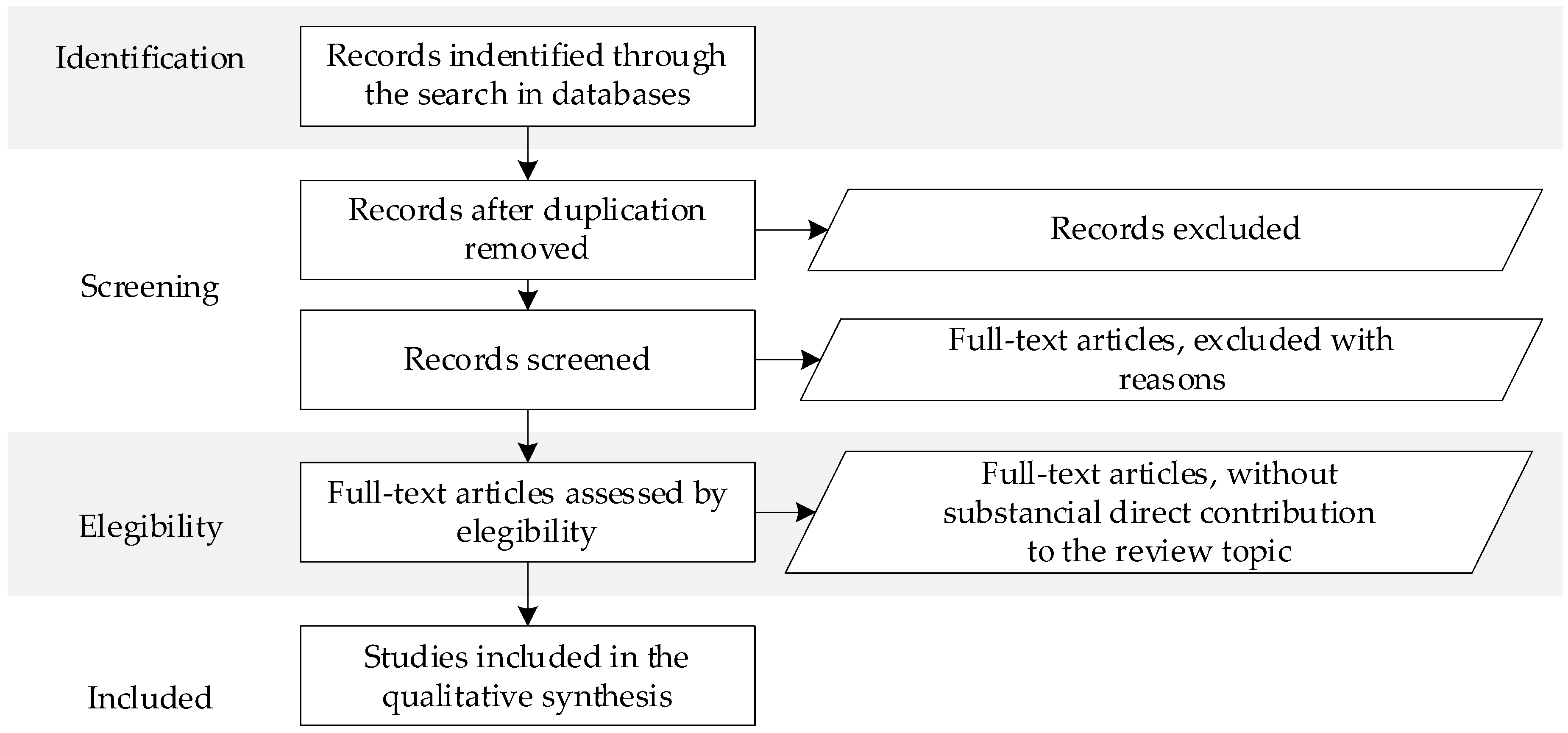
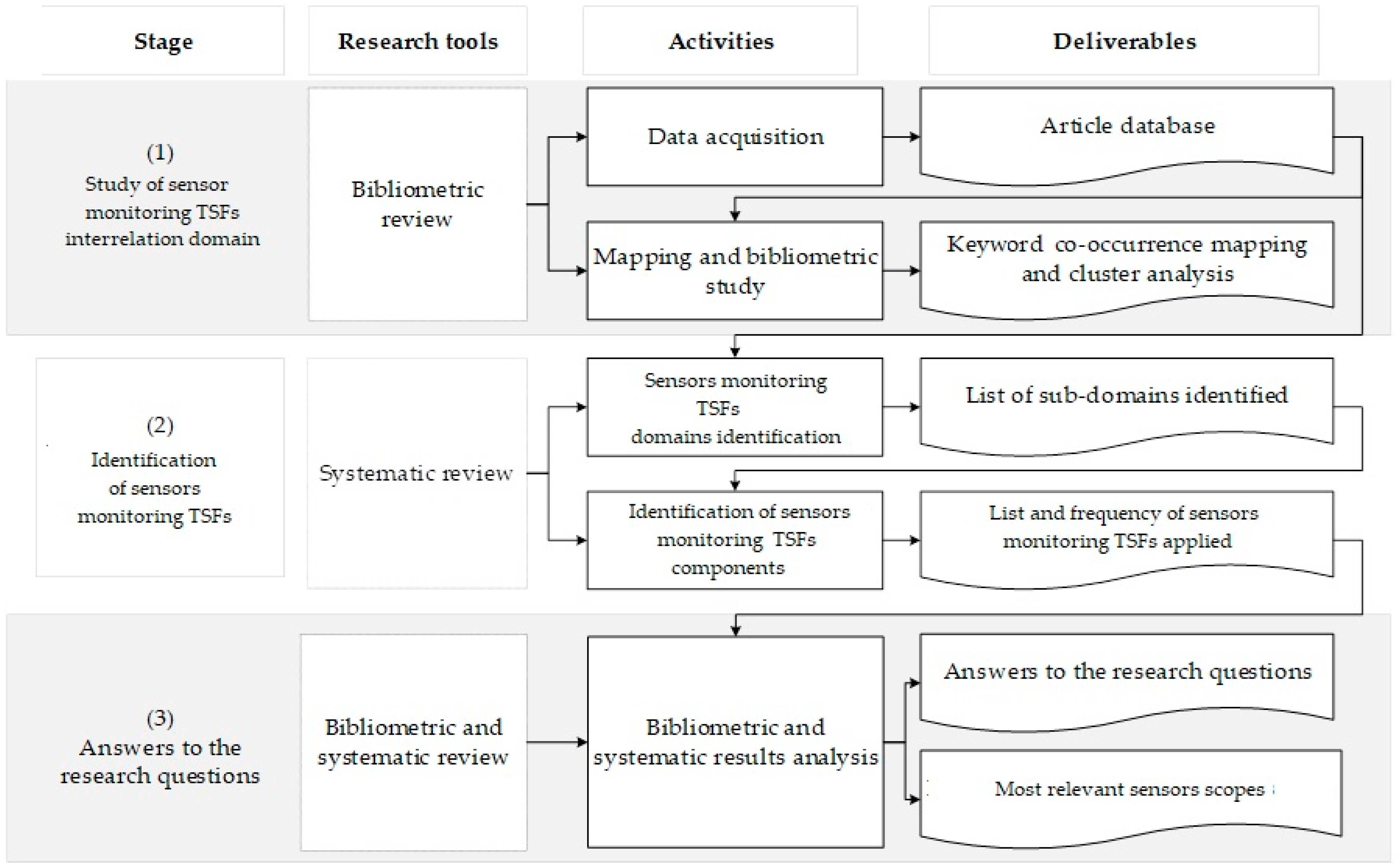

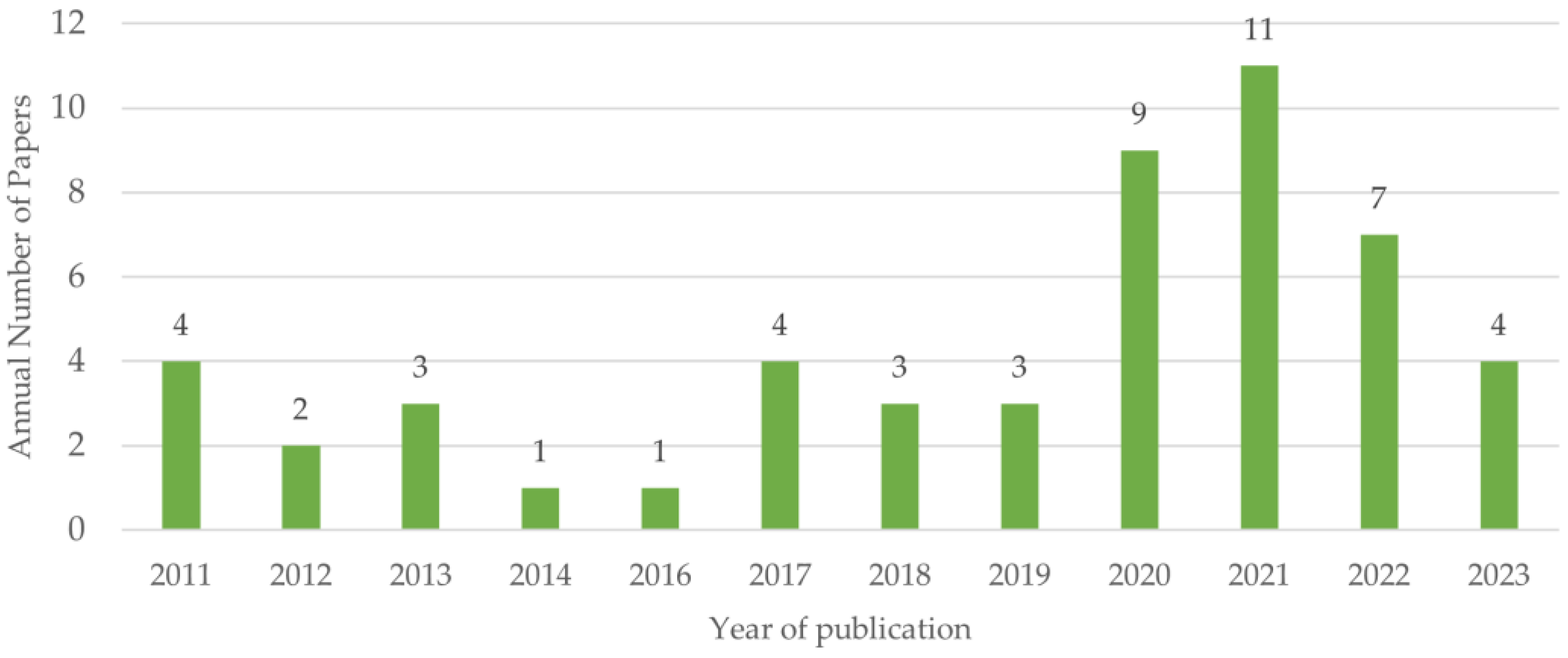

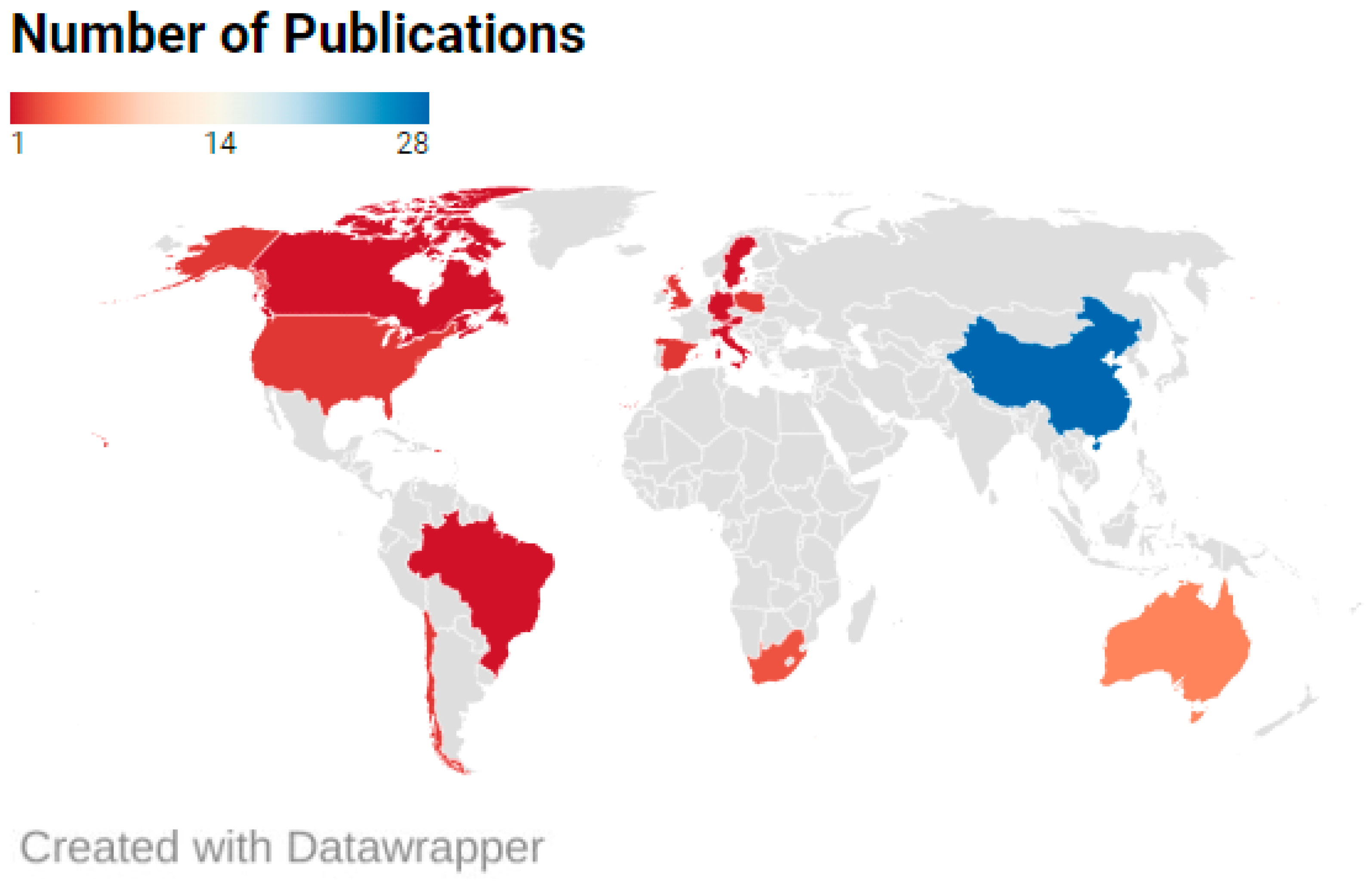
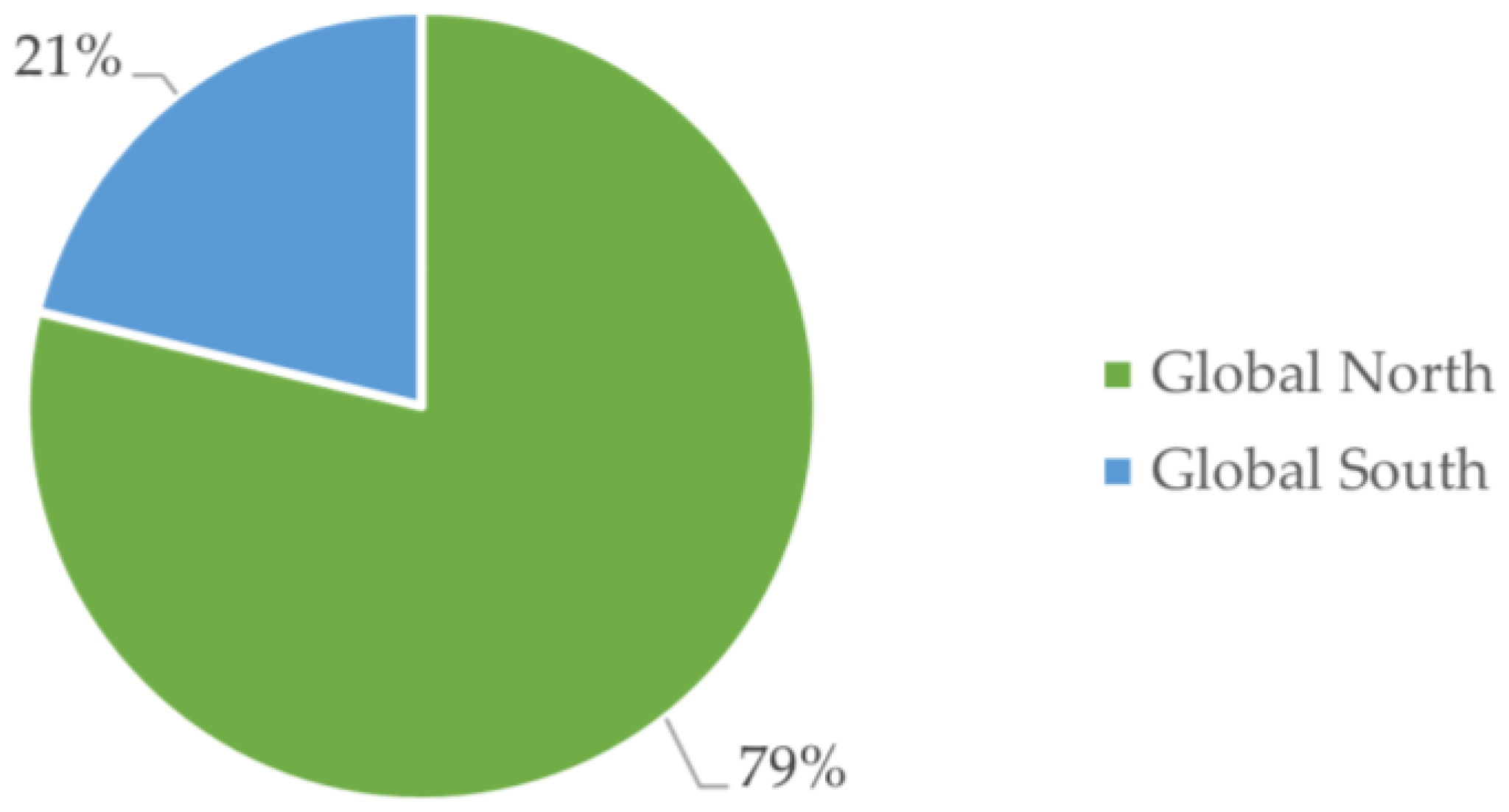
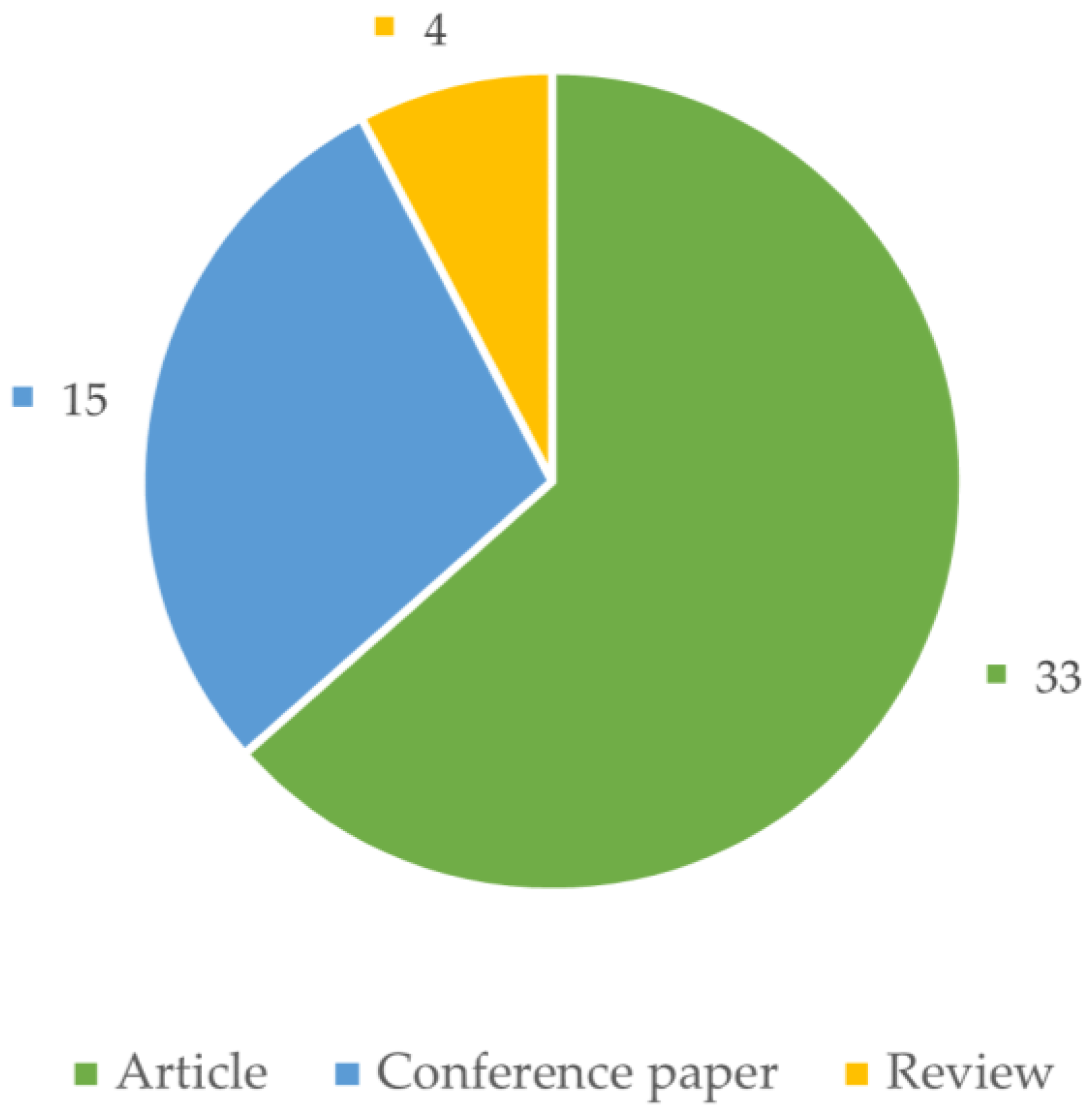
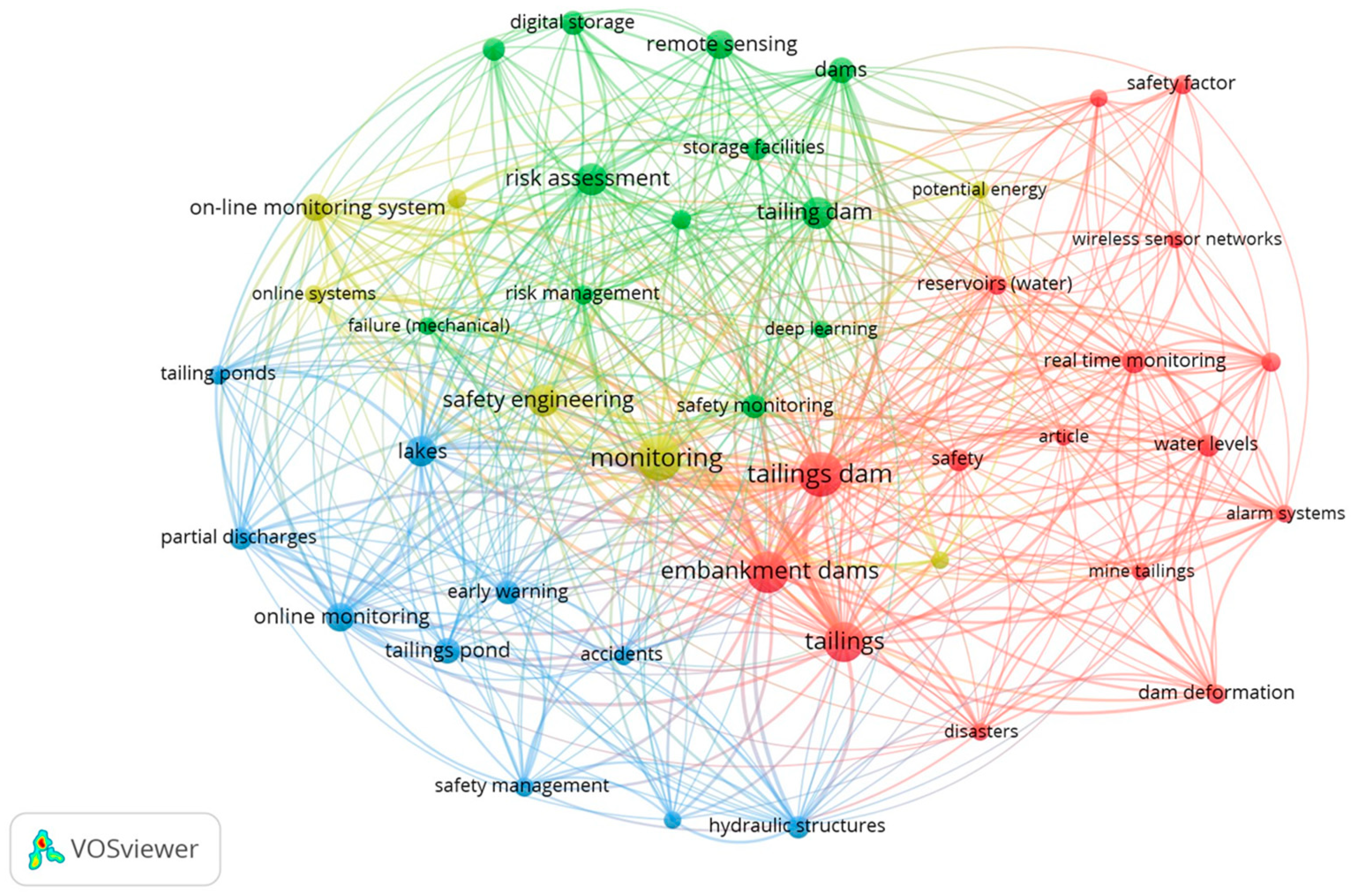
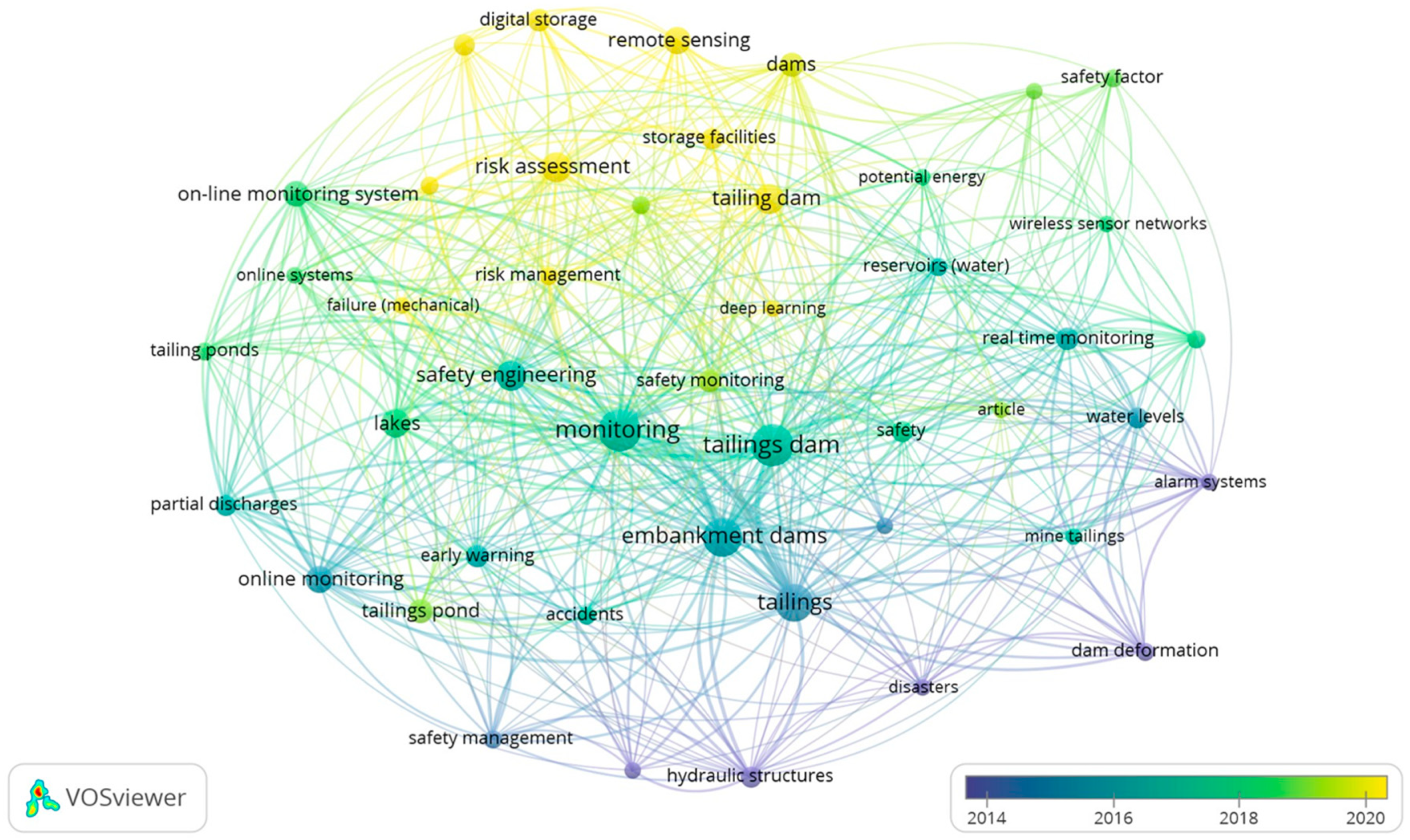

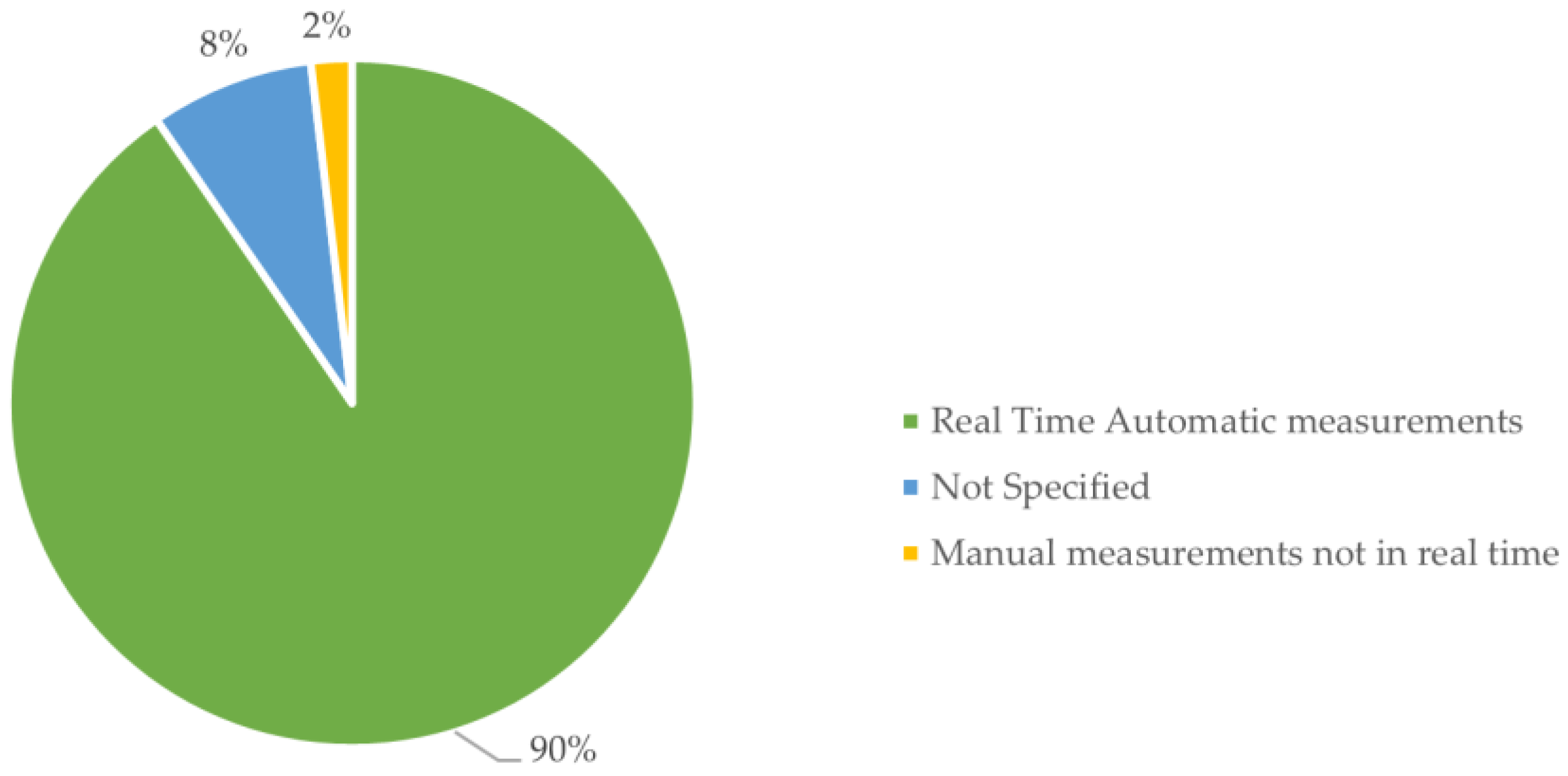
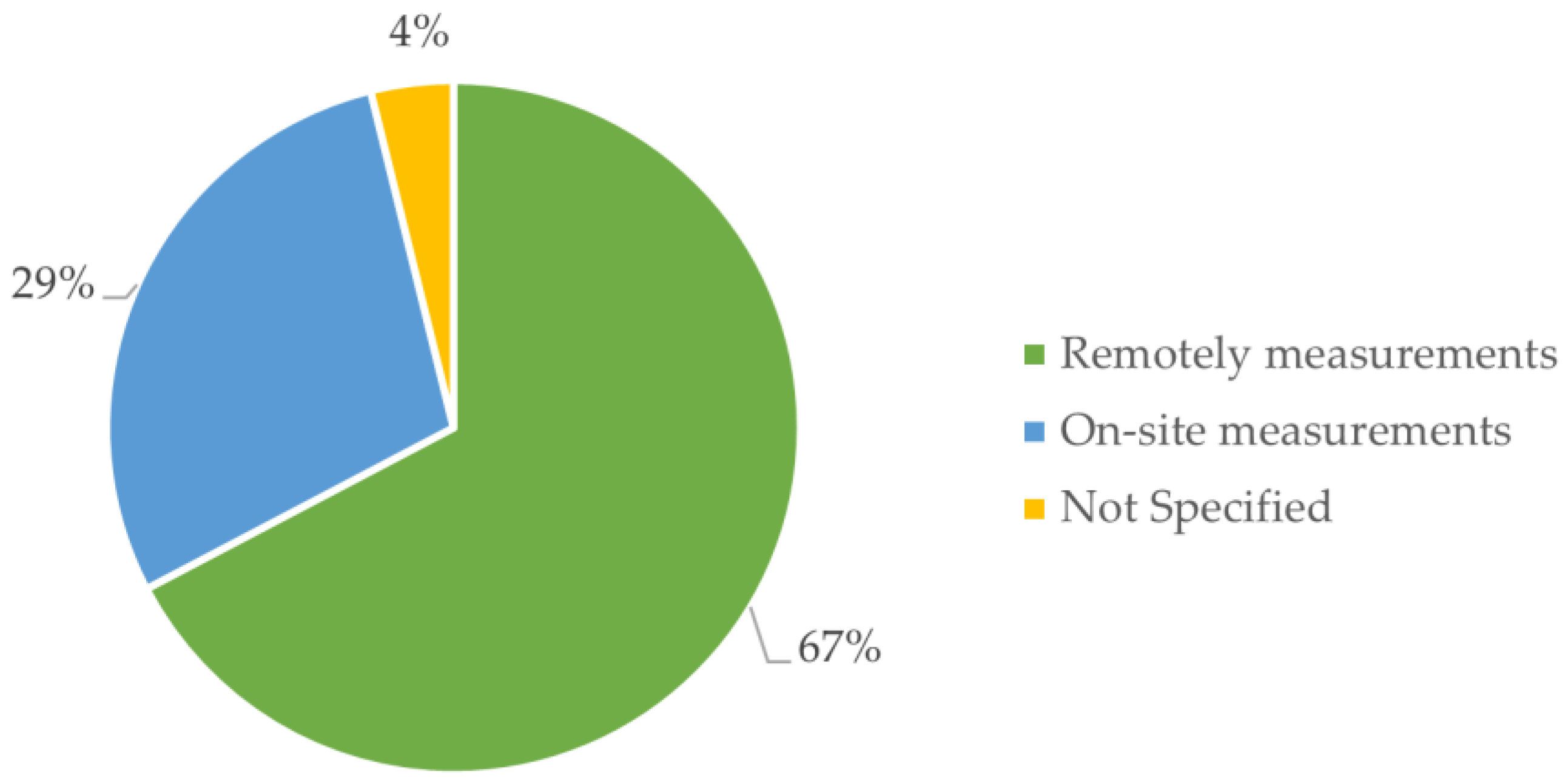





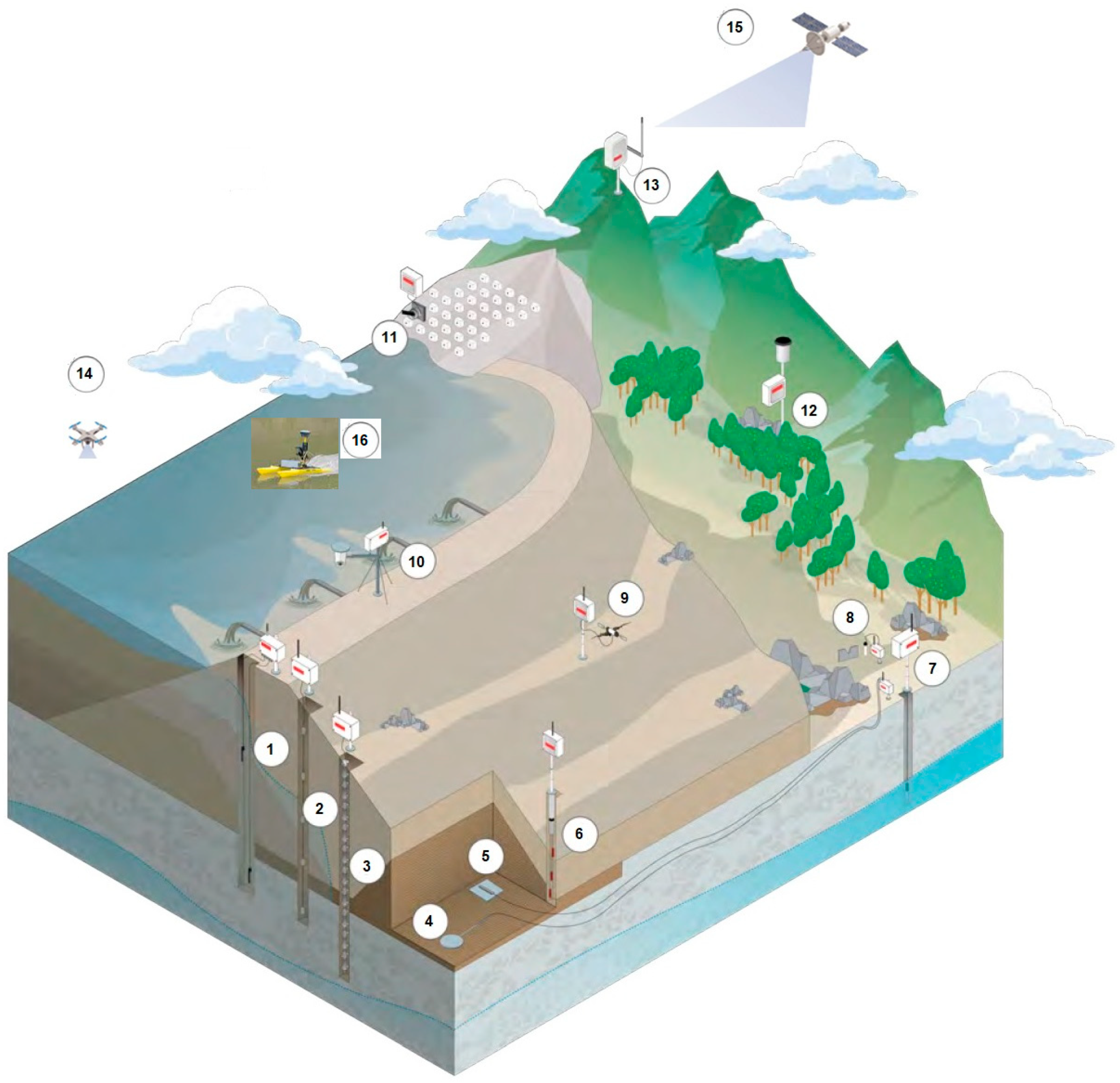



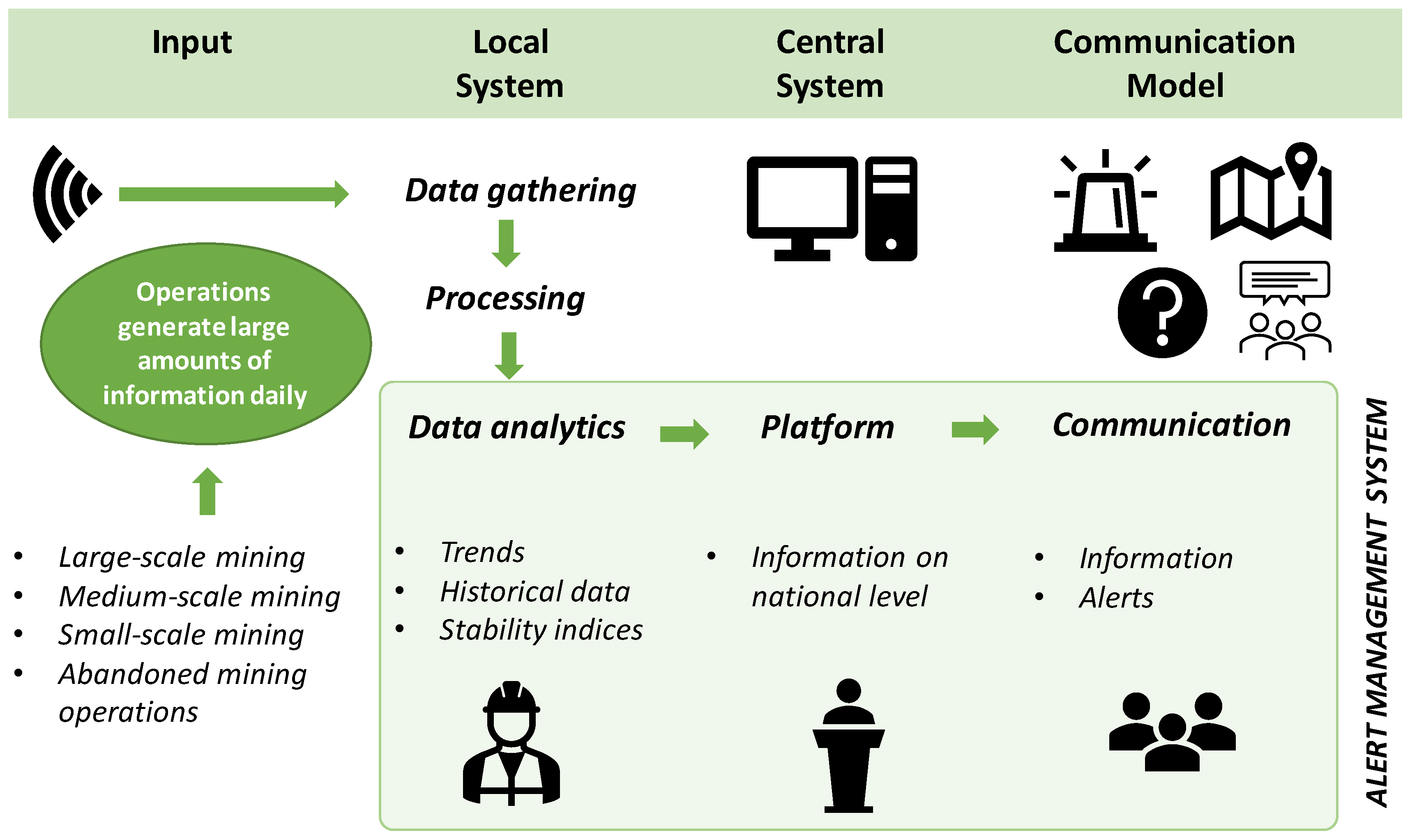
| Keywords | Boolean Operator | Keywords | Boolean Operator | Keywords |
|---|---|---|---|---|
| Sensor | ||||
| Safety | AND | Monitoring | AND | Tailings |
| Risks |
| ID | Approach | Field | Question | Value |
|---|---|---|---|---|
| DEM 1 | Metadata perspective | Keywords | Which are the keywords? | Keywords |
| DEM 2 | Metadata perspective | Title | What is the title? | Name |
| DEM 3 | Metadata perspective | Authors | Who are the authors? | Author List |
| DEM 4 | Metadata perspective | Year | What is the publication year? | Year |
| DEM 5 | Metadata perspective | Country | What is the first author’s country of residence? | Country |
| DEM 6 | Metadata perspective | Document Type | What is the name of the type of document? | e.g., conference paper, article, review, or other |
| DEC7 | Content-based perspective | Popular Clusters | RQ1: How can the sensor concepts applied to TSF be clustered and how have they evolved? | e.g., sensors, safety, risks, monitoring, tailings, among others |
| DEC8 | Content-based perspective | Engineering Disciplines | RQ2: What are the main engineering disciplines in which sensors are applied? | e.g., environmental, geotechnical, and civil, among others |
| DEC9 | Content-based perspective | Measurement Timescale | RQ3: What timescale is used to record measurements with sensor technologies? | e.g., manual measurements (not in real-time), and/or automatic measurements (in real time) |
| DEC10 | Content-based perspective | Measurement Spatial Scale | RQ4: Are the data measurements conducted remotely or on-site with sensor technologies? | e.g., on-site measurements (in place), and/or remote measurements (using remote sensors) |
| DEC11 | Content-based perspective | Sensor Technology | RQ5: What types of sensor technology are applied? | e.g., piezometer sensor, deformation sensor, air quality sensor, among others |
| DEC12 | Content-based perspective | Sensor Connectivity | RQ6: What connectivity technology is applied in sensors? | e.g., using cables, fiber optics, or wireless methods such as WiFi, Zigbee, Bluetooth, Xbee, or LoRa, among others |
| DEC13 | Content-based perspective | TSF Area Application | RQ7: Where are sensors applied within a mine TSF? | e.g., tailings transport area, TSF dam area, and TSF reservoir area, among others |
| DEC14 | Content-based perspective | Technologies in Industry 4.0 | RQ8: What technologies related to Industry 4.0 are currently being linked to sensors? | e.g., data analytics, machine learning (ML), Internet of Things (IoT), and artificial intelligence (AI), among others |
| Cluster Identification | Keywords from Co-Occurrence Analysis | Cluster Interpretation |
|---|---|---|
| Yellow | On-line monitoring, safety engineering, failure | Monitoring |
| Blue | Early warning, tailings pond, accidents | Safety management |
| Red | Real-time monitoring, alarm systems, dam deformation | Wireless sensor networks |
| Green | Deep learning, remote sensing, digital storage | Digital technologies |
| Cluster Identification | Keywords | Average Year of Publication | Cluster Interpretation |
|---|---|---|---|
| Blue | Safety management, alarm systems, dam deformation, water levels. | 2014–2016 | Prevention of accidents and disasters |
| Green | Real-time monitoring, online monitoring, safety engineering | 2016–2018 | Advances in monitoring systems |
| Yellow | Risk management, deep learning, remote sensing, digital storage | 2018–2020 | Digital monitoring with the use of Industry 4.0 technologies |
| # | Reference | Year of Publication | Space Scale Data Measurements | Operation | Connectivity | TSF Area | Engineering Discipline | Use of Cables or Wireless | Industry 4.0 Technology | Cost (USD) |
|---|---|---|---|---|---|---|---|---|---|---|
| 1 | Jeong and Kim [60] | 2019 | R | RTA | 4G | TB | C | W | AI | NS |
| 2 | Basson et al. [61] | 2021 | OS | RTA | SF | TB | G | C | UAVs | Y |
| 3 | Wu et al. [62] | 2017 | OS | RTA | 4G | D | C | W | AI | NS |
| 4 | Guan and Yang [63] | 2020 | NS | RTA | NS | D | G | W | AI | NS |
| 5 | Ma et al. [64] | 2023 | R | RTA | 4G | D | G | W | AI | NS |
| 6 | Dong et al. [65] | 2022 | OS | RTA | NS | D | G | C | AI | NS |
| 7 | Wang et al. [47] | 2021 | OS | RTA | S | D | G | C | CC | NS |
| 8 | Zhang et al. [66] | 2023 | R | RTA | S | D | M | W | UAVs | NS |
| 9 | Yu et al. [67] | 2011 | OS | RTA | 4G | D | G | C | NS | NS |
| 10 | Clarkson and Williams [68] | 2021a | R | RTA | 4G | D | G | W | NS | NS |
| 11 | Clarkson and Williams [37] | 2021b | R | RTA | 4G | D | G | W | NS | NS |
| 12 | López-Vinielles et al. [69] | 2021 | R | RTA | S | D | M | W | NS | NS |
| 13 | Lumbroso et al. [70] | 2020 | R | RTA | S | D | M | W | NS | Y |
| 14 | Hu and Liu [71] | 2011 | R | RTA | S | D | G | W | NS | NS |
| 15 | He et al. [72] | 2013 | R | RTA | Z | D | M | W | IoT | NS |
| 16 | Li et al. [73] | 2020 | R | RTA | S | D | M | W | AI | NS |
| 17 | Sarker et al. [74] | 2022 | R | RTA | S | D | M | W | NS | NS |
| 18 | Yang et al. [75] | 2020 | OS | RTA | 4G | D | G | C | AI | NS |
| 19 | Villavicencio et al. [76] | 2021 | R | RTA | S | D | G | W | AI | NS |
| 20 | Li and Wang [77] | 2011 | R | RTA | S | D | M | W | NS | NS |
| 21 | Zhen et al. [78] | 2020 | NS | RTA | NS | D | M | NS | AI | NS |
| 22 | Yang et al. [79] | 2019 | OS | RTA | 4G | TB | C | C | AI | NS |
| 23 | Cacciuttolo and Atencio [13] | 2023 | R | RTA | Z | RL | C | W | IoT | NS |
| 24 | Balaniuk et al. [80] | 2020 | R | RTA | S | RL | C | W | AI | NS |
| 25 | Wu et al. [81] | 2018 | NS | NRTM | NS | D | C | NS | AI | NS |
| 26 | Mura et al. [82] | 2018 | R | RTA | S | D | G | W | NS | NS |
| 27 | Jing and Gao [83] | 2022 | OS | RTA | 4G | D | G | C | AI | NS |
| 28 | Stefaniak and Wróżyńska [84] | 2018 | OS | NRTM | NS | RL | G | C | NS | NS |
| 29 | Chalkley et al. [85] | 2023 | R | RTA | S | D | M | W | NS | NS |
| 30 | Dong et al. [36] | 2018 | OS | RTA | 4G | D | G | W | IoT | NS |
| 31 | Ruan et al. [86] | 2023 | OS | RTA | 4G | D | G | C | AI | NS |
| 32 | Donovan et al. [87] | 2022 | R | RTA | S | RL | M | W | NS | NS |
| 33 | Zhen et al. [88] | 2022 | OS | NRTM | NS | NS | M | NS | AI | NS |
| 34 | Hu et al. [89] | 2013 | OS | RTA | 4G | RL | C | C | NS | NS |
| 35 | Hui et al. [46] | 2017 | R | RTA | S | D | G | W | IoT | NS |
| 36 | Clarkson et al. [34] | 2020 | R | RTA | Z | D | G | W | IoT | Y |
| 37 | Hao et al. [90] | 2019 | R | RTA | S | D | G | W | NS | NS |
| 38 | Chen et al. [91] | 2019 | OS | RTA | 4G | RL | M | W | AI | NS |
| 39 | Wan et al. [45] | 2012 | R | RTA | S | D | G | W | CC | NS |
| 40 | Zhang et al. [92] | 2014 | OS | RTA | Z | D | M | W | IoT | NS |
| 41 | Lu [33] | 2020 | OS | RTA | NS | RL | M | NS | AI | NS |
| 42 | Du et al. [93] | 2020 | R | RTA | S | D | G | W | NS | NS |
| 43 | Li et al. [94] | 2020 | OS | RTA | 4G | D | G | W | IoT | NS |
| 44 | Cacciuttolo and Cano [4] | 2023 | R | RTA | S | RL | C | W | CC | NS |
| 45 | Haiming and Jing [95] | 2013 | R | RTA | 4G | D | C | NS | NS | NS |
| 46 | Li et al. [96] | 2011 | OS | RTA | 4G | D | G | C | NS | NS |
| 47 | Sun et al. [35] | 2012 | OS | RTA | 4G | D | C | W | IoT | NS |
| 48 | Lumbroso et al. [97] | 2019 | R | RTA | S | D | M | W | NS | Y |
| 49 | Koperska et al. [98] | 2022 | OS | RTA | 4G | D | M | W | IoT | NS |
| 50 | Morton [99] | 2021 | R | RTA | S | D | G | W | IoT | NS |
| 51 | Mazzanti et al. [100] | 2021 | R | RTA | S | D | M | W | NS | NS |
| 52 | Cacciuttolo et al. [32] | 2023 | R | RTA | Z | RL | C | W | IoT | NS |
| Sensor Name | Sensor Typology | Data Obtained/ Variable Measured | Monitoring Results | Monitoring Frequency | Real-Time Monitoring |
|---|---|---|---|---|---|
| Visual inspection by miners | Photographic inspection (observational method) | Dam performance | Interior/exterior, medium reliability, low cost | 1/week | No |
| Visual inspection by EoR | Dam performance | Interior/exterior, medium reliability, low cost | 1/month | No | |
| DSR inspection | Dam performance | Interior/exterior, high reliability, high cost | 1/year | No | |
| ITRB inspection | Dam performance | Interior/exterior, high reliability, high cost | 1/3 years | No | |
| Closed-circuit television camera (CCTV) | Dam performance | Interior/exterior, high reliability, low cost | Every minute | Yes | |
| Meteorological station | Rain/wind/evaporation/solar radiation | Interior/exterior, high reliability, low cost | Every minute | Yes | |
| Accelerometer | Geotechnical instrumentation | 1D/2D/3D seismic accelerations | Interior/exterior, point, high reliability, medium cost | On event | Yes |
| Slope indicator/inclinometer | 1D/2D displacement/slope | Interior/exterior, point, high reliability, low cost, achievable accuracy: 3 mm/10 m | 4/month | Yes | |
| Extensometer | 1D displacement | Interior/exterior, point, high reliability, low cost, achievable accuracy: 0.05 mm/10 m | 4/month | Yes | |
| Casagrande piezometer | Hydraulic head/pore water pressure | Interior, point, high reliability, low cost | 1/week 1/month | No | |
| Vibrating wire piezometer | Hydraulic head/pore water pressure | Interior, point, high reliability, medium cost | Real time | Yes | |
| Tiltmeter | 2D displacement | Interior/exterior, point, high reliability, low cost | 4/month | Yes | |
| Settlement cell | 1D displacement (vertical) | Interior/exterior, point, high reliability, low cost | 2/month | Yes | |
| Distributed optical fiber strain sensors | 1D displacement (strain), acoustics | Interior/exterior, feature, high initial cost for permanent monitoring, achievable accuracy: 10–5 mm/m | |||
| Distributed optical fiber temperature sensors | 1D temperature | Interior/exterior, leak and seepage detection/ localization | |||
| Monitoring wells | Hydraulic instrumentation | Phreatic level | Leak and seepage detection/ localization | 1/week | No |
| Seepage with weir or flume | Seepage flow | Seepage condition | Real time | Yes | |
| Water quality | Metals content | Leak and seepage detection/ localization | 4/month | Yes | |
| Surveying (optical) | Topographical/ bathymetrical/ geodetic devices (remote sensing) | 3D displacement | Exterior, point/ feature, e.g., level profile surveys, labor-intensive | 6/year | No |
| Automated total stations (ATS) | 3D displacement | Exterior, point/ feature, high accuracy, lower labor costs, sub-cm accuracy for distances <1 km | 12/year | No | |
| Global positioning system (GPS)/Global navigation satellite system (GNSS) | 3D displacement | Exterior, point/ feature, real-time kinematics (RTK) can be used to enhance GPS/GNSS measurements | 1/day | Yes | |
| Secondary surveillance radar (SSR) | 3D displacement | Exterior, feature | 1/day | Yes | |
| Light detection and ranging (LiDAR) | 3D displacement, beach crest height | Exterior, feature, high accuracy, point cloud data, high data processing cost | 1/day | Yes | |
| Unmanned aerial vehicles (UAVs)/drones | Mine tailings storage facility panoramic view, dry beach length | Interior/exterior, point, high reliability, medium cost | 1/month | Yes | |
| Unmanned survey vessel (USV) | Mine tailings water pond bathymetry | Interior/exterior, point, high reliability, medium cost | 1/month | Yes | |
| Aerial imaging analysis | 2D/3D displacement | Exterior, feature, stereographic need for vertical displacement | 1/day | Yes | |
| Satellite data analysis | 2D/3D displacement | Exterior, feature, measurement interval limited by satellite return time and atmospheric conditions | 1/day | Yes | |
| Interferometric synthetic aperture radar (InSAR) | 3D displacement | Exterior, feature, ground-based or satellite-borne, sub-centimeter accuracy | 1/day | Yes |
Disclaimer/Publisher’s Note: The statements, opinions and data contained in all publications are solely those of the individual author(s) and contributor(s) and not of MDPI and/or the editor(s). MDPI and/or the editor(s) disclaim responsibility for any injury to people or property resulting from any ideas, methods, instructions or products referred to in the content. |
© 2024 by the authors. Licensee MDPI, Basel, Switzerland. This article is an open access article distributed under the terms and conditions of the Creative Commons Attribution (CC BY) license (https://creativecommons.org/licenses/by/4.0/).
Share and Cite
Cacciuttolo, C.; Guzmán, V.; Catriñir, P.; Atencio, E. Sensor Technologies for Safety Monitoring in Mine Tailings Storage Facilities: Solutions in the Industry 4.0 Era. Minerals 2024, 14, 446. https://doi.org/10.3390/min14050446
Cacciuttolo C, Guzmán V, Catriñir P, Atencio E. Sensor Technologies for Safety Monitoring in Mine Tailings Storage Facilities: Solutions in the Industry 4.0 Era. Minerals. 2024; 14(5):446. https://doi.org/10.3390/min14050446
Chicago/Turabian StyleCacciuttolo, Carlos, Valentina Guzmán, Patricio Catriñir, and Edison Atencio. 2024. "Sensor Technologies for Safety Monitoring in Mine Tailings Storage Facilities: Solutions in the Industry 4.0 Era" Minerals 14, no. 5: 446. https://doi.org/10.3390/min14050446








